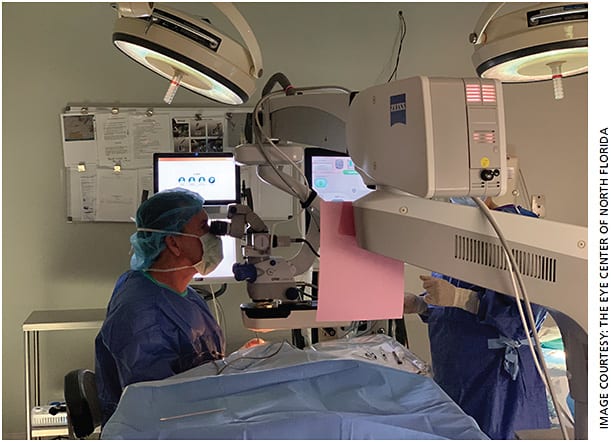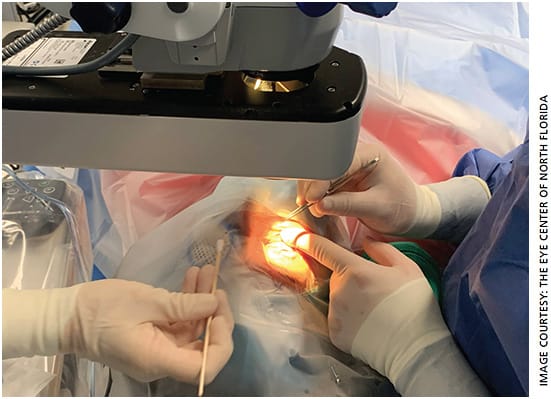As a comprehensive ophthalmologist with an emphasis on cataract and refractive surgery, I perform a large volume of cataract surgery, including those with advanced technology IOLs. Our practice is an integrated one, with both ophthalmologists and optometrists on staff. We have multiple locations and several satellites that are more than an hour drive from our main facility, including our ASC. I also perform surgery on patients referred by local and distant independent optometrists. Therefore, providing postoperative care to my surgical patients frequently involves a coordinated effort among different providers to insure the best outcomes.
Below, I’ll share my strategy for handling postoperative patients and how to ensure they receive the most satisfactory results possible.
THE FIRST POSTOP VISITS
Day-1 postop
I prefer to see my 1-day postops myself, as I really enjoy seeing the early results of the surgery and sharing in my patients’ excitement. However, when this would involve real inconvenience for the patient or when the patient prefers otherwise, I am comfortable sharing my patients’ care with another provider. For these patients, I always make sure to communicate the results of the preoperative exam, the surgery and any follow-up care that I perform to the referring doctor, and I encourage them to provide me with the results of their visits as well. In this setting, I also always want the patient to know they can see me for any or all of their visits after surgery, and I also make sure I receive the results of their visits elsewhere for review.
At the day-1 visit after surgery, I look to see that the visual acuity is in the expected range considering any ocular comorbidities and the appearance of the eye clinically. The IOP should be generally in a physiologic range, with either very low or very high pressures requiring further investigation and/or treatment. The level of postoperative inflammation and discomfort should not be more than is typically present or expected, or I will institute further treatment including additional or more frequent topical steroid and NSAID drops and closer follow-up. Although rare, in any patient in whom I suspect intraocular infection or a TASS-type reaction, I will see the patient back later the same day or early the next day so that I may intervene as quickly as needed or refer as appropriate. Any of the doctors with whom I co-manage patients are aware of my parameters and contact me to discuss any patients outside the norm. A quick text, using patient initials only for HIPAA compliance, can usually suffice for most routine situations with experienced referring physicians. Anything more complex is handled through direct discussion.
If the patient’s vision and clinical appearance are within the expected range at the day-1 visit, their referring physician or I will typically see them again at 1 week. Some patients, however, may wish to schedule surgery for their second eye at this visit if they are significantly anisometropic or have other personal considerations that would make earlier surgery for their fellow eye desirable. I allow this on a case-by-case basis, with the understanding that surgery for the second eye may be delayed if the healing of the first eye does not proceed in the expected manner.
Week-1 postop
At the week-1 visit, the patient should have good vision in the operative eye and be generally satisfied with the results of their surgery. Minimal to no residual inflammation should be present, and the eye should be comfortable. Persistent corneal edema, significant intraoperative inflammation, elevated IOP, unexplained decreased visual acuity or patient dissatisfaction are all reasons to delay scheduling surgery on the fellow eye at this visit and focus on further evaluation and treatment of the operative eye. I typically give any patient who is anxious about their clinical course a business card with my personal contact information, including my personal cell phone number, and encourage them to call, text or email me with any problems or concerns.

PREMIUM IOL PATIENTS
First considerations
For patients receiving “premium” IOLs, including multifocal, EDOF and toric lenses, who pay significant out-of-pocket costs for their surgery, I tend to perform more of the postoperative visits myself to be certain they are satisfied with their uncorrected vision before I send them back to their referring doctor. During this early period after surgery, clinical issues such as optimizing the ocular surface, diminishing intraocular inflammation, preventing macular edema and correcting residual refractive errors are all important considerations in the management of these patients.
Managing the ocular surface
Management of the ocular surface may be as simple as having the patient use additional artificial tears during the early postoperative period. However, I am always prepared to employ the full range of dry eye and meibomian gland disease treatments, including punctal plugs, pharmacologic agents to increase tear production, eyelid hygiene and direct treatment of the lid margins. I have found that the use of the DEXTENZA (Ocular Therapeutix) intracanalicular dexamethasone insert during surgery has lessened the need for many of these interventions immediately postop, while many of the more modern advanced technology IOLs, such as the PanOptix trifocal lens implant (Alcon) and the Vivity (Alcon) and Symfony (Johnson & Johnson Vision) EDOF lenses, seem to be more tolerant of mild degrees of dryness or ocular surface disease.
Intraocular inflammation
To prevent infection and treat intraocular inflammation associated with cataract surgery, I use a combination of intravitreal and intracameral steroids, non-steroidals and antibiotics, as well as an intracanalicular steroid implant wherever possible. I find that by using a combination of intravitreal dexamethasone, moxifloxacin and ketorolac (Imprimis Pharmaceuticals), in combination with either Omidria (Omeros) or DEXTENZA or both, I can avoid the use of postoperative drops altogether. DEXYCU (EyePoint) is another option for those looking to lessen or eliminate postoperative drops. This approach greatly simplifies shared management of the patient’s care after surgery while increasing both patient compliance and satisfaction. The occasional case of breakthrough iritis can be managed simply with a topical NSAID drop such as Ilevro (Alcon), Prolensa (Bausch + Lomb) or Bromsite (Sun Ophthalmics) given once or twice a day for 7 to 14 days.

Ensuring patient satisfaction
Managing intraocular inflammation is critical in preventing cystoid macular edema, which can lead to transient and, rarely, permanent impairment of vision. Optimizing the ocular surface is likewise important in insuring good long-term vision. However, even with these issues successfully managed, residual refractive error can lead to reduced uncorrected vision and decreased satisfaction in some patients. The tolerance of residual refractive error can vary among patients and implants. Therefore, we always strive to achieve good vision as perceived by the patient rather than a specific visual acuity.
In the case of premium IOL patients, I am quick to offer laser vision correction where appropriate to any patient who is not completely satisfied with their postoperative uncorrected vision. With these patients, I try to be honest while maintaining a relentlessly optimistic attitude. I strive to maintain open body language and avoid doing anything to appear defensive. Most importantly, I let them know that we are in this together, and I will not give up or quit as long as they are also committed to the process. I typically wait a minimum of 6 weeks after the original cataract surgery and almost always perform femtosecond flap LASIK to achieve the quickest recovery and optimize patient satisfaction. I generally proceed with surgery on the patient’s second eye while waiting to perform LASIK on the first eye, if the patient is comfortable with this approach. I do not charge patients for these “touch ups,” which I perform in fewer than 5% of my premium IOL patients.
In some cases, I see a premium IOL patient for up to 3 months before releasing them back to their referring physician, as we work together to optimize their vision and results from the surgery. During this time, some patients may begin to develop early capsular haze and require Nd:YAG laser capsulotomy. I typically try not to perform this before the 3-month mark to ensure both that the lens is stable and, in the case of a presbyopia-correcting IOL, that the patient is successfully adapting to their new lens and does not require an IOL exchange. Thankfully, patient adaptation to newer IOLs is extremely good and IOL exchange is extremely rare in my practice. This is very different from the early generations of multifocal IOLs when IOL exchange was more common. If a patient also appears to have a late refractive shift with decreased uncorrected vision, I also like to be certain this is not a result of changes in the posterior capsule before considering LASIK.
CONCLUSION
Providing excellent postoperative care to our cataract patients in the era of modern surgery and advanced lens implants can be accomplished in the setting of a busy clinical and surgical practice and with varying degrees of co-management. Recognizing and being prepared to manage or comanage common postoperative issues that arise will ensure that patients achieve good results and are very satisfied with their surgical experience. OM









